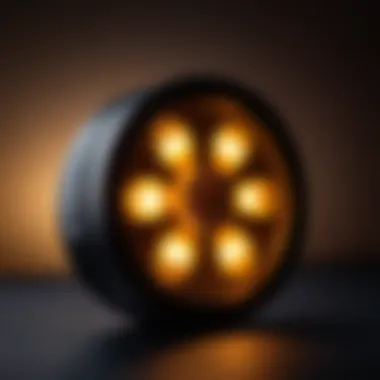Battery-Powered Night Lights: A Comprehensive Guide


Intro
Battery-powered night lights serve an important role in many households. Whether it’s for enhancing the ambiance of a room or simply guiding individuals during nighttime, these devices offer versatile solutions. They use various technologies, primarily LED, to provide efficient and practical lighting options without the need for cumbersome wiring.
In today’s fast-paced world, the need for portable and effective lighting is more relevant than ever. Families with children, students living in dormitories, and budget-conscious individuals are likely to benefit from understanding battery-powered night lights. This thorough exploration will not only highlight their designs and functionalities but will also address the practicalities of use in various settings.
Актуальные акции и скидки
Обзор текущих предложений
Various retailers often have promotions on battery-powered night lights. Checking local stores or online platforms like Amazon can reveal seasonal discounts. Some brands may also provide introductory offers for new products, significantly lowering the price for consumers.
Специальные предложения от популярных брендов
Popular brands such as Philips, Casper, and Energizer often feature special deals. These deals are worth exploring, as they can make high-quality products more accessible. Brand loyalty can lead to additional savings through loyalty programs and contests.
With the authority of the brands established, it's essential to understand what makes each product unique, especially in design and function. Readers looking for a balance between price and quality must remain discerning.
Rекомендуемые товары
Топ товаров со скидками
Here are several products that stand out for their functionality and discounted prices:
- Philips Hue White Ambiance: A smart option with customizable brightness.
- Casper Glow Light: Offers a gentle dimming feature, great for children.
- Energizer Battery Operated LED Nightlight: Affordable and functional, with energy-saving capabilities.
Товары, которые стоит купить по сниженной цене
During sales events, certain items receive hefty markdowns:
- Lepni.me Night Light: Fantastic designs that appeal to children, often on sale.
- Vont LED Night Light: Known for efficiency, it usually comes with a good discount.
Keeping an eye on such discounts allows consumers to make informed decisions without breaking the bank.
"Battery-powered night lights provide a convenient and energy-efficient solution for contemporary living, catering to safety and ambient needs."
As more people seek smart home solutions, battery-powered lighting will continue to evolve. Understanding the background and variety will help you make informed purchasing choices.
Understanding Battery-Powered Night Lights
Battery-powered night lights serve more than just a decorative purpose in our homes. They provide safety, guidance, and peace of mind during the hours of darkness. The importance of comprehending these essential lighting devices lies in their multifaceted functionality and adaptability to various settings.
Choosing the right battery-powered night light can significantly enhance one’s living space. Such lights illuminate pathways, rooms, and even specific corners needing attention without the necessity for wired installations. They are particularly beneficial in homes with children, elderly family members, or anyone needing reassurance when moving about at night.
Definition and Purpose
A battery-powered night light is a small illumination device that operates on batteries rather than continuous mains electricity. Its primary purpose is to provide low-level lighting to promote safety and ease of movement in low-light conditions. Often designed to be compact and energy-efficient, these lights fulfill various roles.
- Safety: They offer a sense of security for individuals navigating dark spaces, reducing the risk of falls or accidents.
- Navigation: These lights often serve as guides, lighting up the way to essential areas, such as bathrooms or hallways.
- Comfort: For children, a soft-glowing night light can provide reassurance, helping to ease fears of the dark.
Historical Context
The concept of night lighting has evolved over many centuries, shaped by technological advancements and cultural needs. Initially, homes relied on candles, oil lamps, or gas lighting to navigate during the night. While effective, these traditional sources presented challenges concerning safety and efficiency.
The introduction of electric lights in the late nineteenth century transformed how people illuminated their surroundings. However, the wired nature of these systems limited flexibility and added complexity to installation. The rise of battery-powered devices came as a response to these limitations in the late twentieth century, reflecting a growing demand for safety and convenience. With advancements in LED technology and battery design, modern battery-powered night lights offer unprecedented performance and usability.
This historical progression underscores the significant shift toward portable, energy-efficient lighting solutions that cater to diverse user needs. Today, battery-powered night lights exemplify innovation, combining aesthetics with functionality, thus meeting the varied demands of contemporary living.
"The growing reliance on battery-powered lighting reflects not only technological advancements but also social shifts in how we perceive safety and comfort in our homes."
Understanding the definition and historical context of battery-powered night lights highlights their crucial role in modern living spaces. This knowledge serves as a foundation for informed decisions when selecting lighting solutions that align with individual needs.
Types of Battery-Powered Night Lights
Understanding the various types of battery-powered night lights is crucial for consumers who want to choose the right product for their specific needs. Each type offers unique benefits, considerations, and applications, making it important to explore their functionalities in detail. The primary types include LED, halogen, and incandescent night lights, which differ in their energy consumption, brightness level, and overall performance. By examining these types, consumers can make informed decisions that align with their requirements.
LED Night Lights
LED night lights are widely recognized for their energy efficiency and long lifespan. Unlike traditional bulbs, LED lights consume significantly less power while providing bright illumination. This makes them an excellent choice for continuous use, especially in areas like hallways or nurseries where light is needed throughout the night.


Another advantage of LED night lights is their low heat emission. This reduces the risk of overheating and makes them safer to use in various environments, including children's rooms.
However, potential buyers should consider the color temperature and brightness settings. Some LEDs emit a colder, bluish light that can interfere with sleep patterns. Opting for warmer tones can mitigate this issue, creating a more soothing atmosphere that encourages restfulness.
Halogen Night Lights
Halogen night lights are another option, known for producing a bright, focused light. They operate at higher temperatures and can illuminate a space more effectively than some other types. This makes them a good choice for areas where visibility is crucial, such as stairways or bathrooms.
While they provide excellent brightness, halogen lights generally consume more energy compared to LED lights. Users should weigh the intensity against the energy cost when deciding on this type. Halogen bulbs also have a shorter lifespan and can pose a fire risk if not used properly, especially when in contact with flammable materials.
As a general guide, these night lights suit situations where light output is prioritized over long-term energy savings.
Incandescent Night Lights
Incandescent night lights represent the traditional lighting option. Although they tend to be less energy-efficient than their LED and halogen counterparts, they produce a warm light that many find comforting. This characteristic can make incandescent lights appealing for bedrooms or children's rooms.
Their simplicity and ease of use are definite advantages. Users can generally find these lights at lower prices, although the increased energy consumption will add to utility costs over time. The bulbs also heat up considerably during use, which can be a safety concern in spaces where they might be touched frequently.
In summary, incandescent night lights may work for people who need temporary or occasional light rather than continuous use.
Key Features of Battery-Powered Night Lights
Understanding the key features of battery-powered night lights is vital for consumers. These features dictate the performance, usability, and suitability of different models for specific settings. When evaluating such products, it is essential to consider how each characteristic aligns with user needs, ranging from convenience to energy efficiency.
Light Intensity Options
Light intensity options play a significant role in the selection of night lights. Not all rooms require the same level of brightness. For instance, a gentle glow may suffice for a child's room, while a more robust light may be necessary in hallways or bathrooms. Typically, battery-powered night lights come with adjustable brightness settings, allowing users to tailor the illumination according to their preferences.
Moreover, many modern night lights use LED technology, which often features dimmable functions. This flexibility enables effective light management, contributing to a calming ambiance while still providing sufficient illumination.
Sensor Technologies
Sensor technologies enhance the functionality of battery-powered night lights. Many devices are equipped with motion sensors, which activate the light only when movement is detected. This function not only extends battery life but also offers convenience. For example, when someone enters a dark room, the light will automatically illuminate, which eliminates the need to fumble for a switch.
Another common feature is the ambient light sensor. This can detect the level of natural light and adjust accordingly. Thus, when the room is dark, the night light turns on without user intervention. This adaptability is beneficial, particularly in children's rooms or shared spaces, providing safety without the need for constant manual operation.
Battery Life Considerations
Battery life is a critical factor when choosing night lights. The duration a light remains operational on a single charge can greatly influence practicality. Generally, LED night lights consume less energy, translating to longer battery life. Users should consider the type of batteries used as well; rechargeable options often provide significant savings in the long run compared to single-use batteries.
In addition, factors such as the frequency of use and brightness settings affect battery life. A high-intensity setting will consume power more quickly than a lower setting. Therefore, understanding one’s usage habits will aid in selecting a product that offers sufficient battery longevity for expected needs.
"Selecting the right features ensures that the night light not only meets functional needs but also fits into the lifestyle of the user."
Advantages of Using Battery-Powered Night Lights
Battery-powered night lights provide numerous advantages that enhance their practical utility both at home and in various settings. Their distinct features cater to diverse user needs, making them an attractive choice for many households.
Portability and Versatility
One of the primary benefits of battery-powered night lights is their portability. These lights can be easily relocated, giving users flexibility in where they choose to illuminate their environment. For instance, a battery-powered night light can be placed in a child's room, moved to a hallway, or even taken outside during a camping trip. This versatility allows them to cater to different activities and locations.
Additionally, the design options are often varied. Users can find night lights in various shapes, sizes, and colors, making it easier to match their aesthetic preferences. Battery-powered lights can serve functional purposes in multiple situations, whether as a night light for young children, an accent light for decor, or practical illumination during emergencies.
Energy Efficiency
Battery-powered night lights typically excel in energy efficiency. Many of these lights use LED technology, which consumes significantly less power compared to traditional incandescent or halogen bulbs. As a result, users can enjoy extended battery life and reduced environmental impact.
Moreover, the presence of motion sensors in some models becomes an additional plus. These sensors activate the light only when motion is detected, ensuring that energy is used only when necessary. This feature maximizes battery duration, allowing users to replace batteries less frequently.
Ease of Installation
Another advantage is the ease of installation. Battery-powered night lights do not require complex electrical setup or access to power outlets, differentiating them from wired options. Users can typically find adhesive options or battery-operated lights designed to stand freely.
This means that even individuals with minimal DIY experience can install these lights without issues. By simplifying the installation process, battery-powered night lights can be utilized immediately upon purchase, enhancing user convenience and satisfaction.
"Battery-powered night lights stand out for their flexibility, efficiency, and simple installation, making them an appealing choice for various applications."
In summary, the advantages of battery-powered night lights are significant. Their portability and versatility, combined with energy efficiency and ease of installation, create a compelling case for their use in diverse settings.


Potential Drawbacks of Battery-Powered Night Lights
When considering battery-powered night lights, it is essential to understand their potential drawbacks. While they offer convenience and ease of use, there are certain limitations that could influence a consumer's decision. Recognizing these factors allows users to make informed choices that best suit their needs.
Dependence on Battery Replacement
One of the most significant drawbacks of battery-powered night lights is their dependence on battery replacement. Unlike hardwired lighting options, which rely on a continuous power source, these lights function solely on the energy supplied by batteries. This reliance creates several issues.
First, if the batteries run low or die unexpectedly, users may find themselves without light when it is needed the most. This situation can be particularly inconvenient during nighttime hours when visibility is critical.
Second, battery replacement can also incur additional costs over time. Consumers must consider the expense of purchasing quality batteries that can support the light's functioning effectively. Depending on usage, these costs can accumulate.
Finally, frequency of battery replacement can depend on the specific light's usage. For example, a night light left on for long hours will obviously consume more battery than one used intermittently. This cycle of replacement can create a sense of frustration and diminish the convenience that these lights are supposed to provide.
Variable Light Quality
Another concern is the variable light quality found in battery-powered night lights. Not all battery-operated options provide consistent brightness or color temperature. Different types of bulbs, such as LED, halogen, or incandescent, produce varying levels of light quality.
For instance, some cheaper models may emit a dim light, insufficient for navigational purposes. Conversely, higher-end LED options might offer excellent illumination but at a premium price. Users should also note that the light quality might change as the batteries lose power. This fluctuation can be problematic, especially in circumstances requiring reliable and consistent lighting.
"The variable quality of light can lead to either frustration or satisfaction. Understanding the product specifications is crucial."
Cost Implications
Cost is another vital consideration regarding battery-powered night lights. Although these lights are often marketed as affordable solutions, the total cost can extend beyond the initial purchase price. Users must factor in the cost of batteries, which can differ significantly based on quality and brand. Cheaper batteries may save money initially but might need frequent replacements, thus raising their long-term expense.
Additionally, some battery-powered lights offer features such as motion detection or smart controls. While these can enhance usability, they also tend to come with higher price tags. Balancing cost and the desired features becomes essential for consumers, particularly those on a fixed budget.
Applications of Battery-Powered Night Lights
Battery-powered night lights have evolved into versatile tools for illumination in various settings. Their ability to function without being tethered to a power source expands their usability, making them ideal companions for numerous applications. Understanding the diverse areas where these lights shine can lead to informed decisions, particularly for consumers interested in affordability and utility. The exploration of these applications also highlights their practicality for families, travelers, and those preparing for emergencies.
Home Use
One of the most common applications of battery-powered night lights is within the home. They provide gentle illumination, perfect for hallways, nurseries, and children's rooms. Many parents appreciate having a night light in their child's room, easing fears of darkness without overwhelming brightness.
- Safety in Movement: Night lights help guide movement in the home during nighttime hours, reducing the risk of accidents caused by stumbling in the dark.
- Ambiance Creation: These lights can create a calming atmosphere, contributing to a more relaxing environment conducive to sleep.
- Convenience of Location: Battery-operated designs mean that these lights can be positioned anywhere, ensuring comfort wherever needed.
Travel and Outdoor Activities
Battery-powered night lights are especially useful for travel and outdoor adventures. When staying in hotels or camping, travelers often face unfamiliar environments. Here, portable night lights can add comfort and security.
- Portability: Their lightweight nature makes them easy to pack in luggage. Various models have compact designs, taking little space.
- Dual Purpose: Many battery-powered lights also function as a flashlight, making them practical for both indoor and outdoor use.
- Safe Exploration: These lights allow for safe movement during camping trips or hikes, especially at night.
Emergency Preparedness
In emergencies, reliable lighting is crucial. Battery-powered night lights serve as essential tools in preparedness plans, always needed when power outages happen.
"Having a reliable source of light during a blackout can mitigate panic and provide reassurance."
- Readiness: Keeping battery lights handy ensures that they are available whenever electrical failures arise.
- Guidance and Visibility: They can help locate emergency supplies or navigate a home safely until power returns.
- Non-reliant on Mains Power: As they function independently of household electricity, they remain operational when needed the most.
Choosing the Right Battery-Powered Night Light
Selecting the appropriate battery-powered night light is crucial for several reasons. The right choice can dramatically impact safety, comfort, and energy efficiency in various settings. It often goes beyond mere aesthetics; it connects with practical needs such as illumination intensity, battery longevity, and the specific environment where it will be used. Understanding one's requirements is the first step toward making an informed decision that enhances everyday living.
Identifying User Needs
Before diving into features and pricing, it is essential to clarify what the user truly needs. Different scenarios demand different lighting solutions. For instance, families with young children may prioritize soft, reassuring light, while those emphasizing portability for travel or camping may seek lightweight, compact designs.
Some key considerations include:
- Purpose: Will it serve mainly for navigation or create a calming atmosphere?
- Location: Is it for a hallway, bedroom, or outdoor use? Each space has unique requirements.
- User Demographics: Are children, elderly, or pets in the area? Adjustments may be needed based on who interacts with the light.
Thus, identifying user needs leads to a tailored search where choosing the right model becomes straightforward.
Evaluating Features
Once the user needs are understood, evaluating specific features of battery-powered night lights is next. Different designs and technologies play a significant role in performance and satisfaction. Consider the following features during the evaluation process:


- Light Intensity: Options should match the intended use; softer light for children's rooms and brighter for halls.
- Sensor Technology: Automatic on/off capabilities that utilize motion detection can conserve battery life.
- Battery Type: Rechargeable or replaceable batteries offer flexibility, but users should consider which suits their lifestyle best.
A thorough evaluation helps to match a light's specifications with user expectations, ensuring functionality and efficiency.
Balancing Cost and Quality
Cost is often a significant factor in decision-making, but it shouldn't overshadow quality. Consumers may find cheaper light options that seem appealing, but quality is essential for durability and performance.
Factors to balance include:
- Initial Investment: Assess how much is spent initially; sometimes it’s worth investing a little more for better features.
- Long-term Savings: Energy-efficient models can reduce electricity costs over time.
- Warranty and Support: A model with a solid warranty can assure quality and durability.
People should approach the evaluation methodically. Taking time to weigh costs against anticipated benefits normally leads toward better decisions.
"Making the right choice in battery-powered night lights involves understanding personal needs, evaluating features comprehensively, and balancing cost with quality. "
In summary, choosing the right battery-powered night light is not merely about illumination; it's about integrating it smoothly into one’s living environment for safety, convenience, and aesthetic appeal.
Maintenance and Care
Maintaining battery-powered night lights is essential not only for their functionality but also for their longevity. By being proactive in care, users can ensure these devices remain reliable and effective. Important considerations include battery management, cleaning practices, and proper storage. Each of these elements plays a vital role in keeping night lights in good working condition.
Battery Management Tips
Effective battery management is critical for optimal performance of battery-powered night lights. Here are some practical suggestions:
- Select the Right Battery Type: Use the brand and type of batteries recommended by the manufacturer. Different devices may require different battery specifications, and using the incorrect type can lead to poor performance or damage.
- Regular Checking: Frequently check battery levels. Some lights offer a battery indicator. If not, take time to test batteries regularly to avoid sudden outages.
- Rotate Usage: If possible, rotate between multiple lights to distribute wear across devices. This can prolong battery life by preventing overuse of a single unit.
- Avoid Over-Discharging: Replace batteries before they completely die. Deep discharging can reduce overall battery lifespan, particularly with rechargeable types.
Cleaning and Upkeep
Routine cleaning of battery-powered night lights is also necessary. Dust and grime can affect functionality. Here are effective cleaning strategies:
- Use Soft Cloths: Wipe the exterior with a soft, damp cloth. Avoid abrasive materials, as they can scratch the surface.
- Remove Accumulated Dust: Regularly check and carefully clean areas where dust accumulates, such as around the light source or sensors. A small brush can aid in removing debris without harming the device.
- Inspect for Smudges: If the light has a lens, look for smudges. A microfibre cloth is good for cleaning lenses without leaving streaks.
Storage Suggestions
Proper storage is a key factor in extending the lifespan of night lights. Consider the following:
- Cool, Dry Locations: Store lights in cool, dry areas. Excessive heat or moisture can damage electrical components and batteries.
- Remove Batteries for Long-Term Storage: If planning on not using the light for an extended period, remove the batteries. This prevents battery leakage that can corrode and damage the device.
- Store in Original Packaging: If practical, keep the lights in their original packaging. This can protect them from movement and dust.
In summary, the care of battery-powered night lights encompasses battery management, cleaning, and storage. Each aspect contributes not only to the functionality but to the safety and efficiency of these lighting solutions.
Market Trends and Innovations
In the rapidly evolving landscape of battery-powered night lights, market trends and innovations play a quintessential role. With consumer preferences shifting towards smarter and more sustainable solutions, manufacturers are rethinking their approaches. This section highlights key elements of recent advancements and considers the benefits for users.
Smart Night Light Features
The integration of smart technology into night lights has become a significant trend. Smart night lights often incorporate capabilities such as remote control via smartphones, integration with home automation systems, and customizable light settings. These features enhance user convenience significantly. For instance, a smart night light can be programmed to turn on automatically at sunset, providing a seamless transition from daylight.
The convenience of modern technology goes beyond mere luxuries. For families with young children or elderly members, accessibility becomes a vital concern. Smart night lights can be manually adjusted to ease transitions during nighttime activities, such as bathroom visits or feeding. Moreover, night lights equipped with motion sensors offer additional safety by illuminating paths when movement is detected.
"Smart features in night lights not only provide functionality but also elevate safety and comfort in the home environment."
Sustainability Efforts in Production
With growing awareness of environmental issues, sustainability is becoming increasingly important in the production of battery-powered night lights. Manufacturers are now adopting eco-friendly materials and processes. Many brands focus on using recyclable plastics and biodegradable components wherever possible.
Sustainable practices also extend to energy consumption. Recent innovations include the use of solar-powered night lights, which further reduce reliance on batteries. This is appealing for consumers who are conscious about their carbon footprint. Additionally, companies are now making efforts to design products that maximize battery efficiency, extending the life of both rechargeable and disposable batteries.
Here are some considerations regarding sustainability in battery-powered night lights:
- Material Choices: Opting for recyclable and eco-friendly materials.
- Energy Efficiency: Designing lights that minimize power usage.
- Production Processes: Implementing greener manufacturing methods.
In summary, understanding market trends and innovations surrounding battery-powered night lights equips consumers with insights into the latest technologies and sustainability practices. This knowledge fosters informed decisions that not only improve home lighting but also contribute positively to the environment.
Closure
The conclusion serves as a pivotal part of the discussion regarding battery-powered night lights. It not only encapsulates the key points covered throughout the article but also emphasizes the significant benefits and considerations associated with these lighting solutions. Understanding the nuances of battery-powered night lights can help users make informed decisions, ensuring that they choose products that not only suit their needs but also enhance their environments effectively.
Summary of Findings
In summary, battery-powered night lights present a diverse range of options that cater to varying user requirements. We have explored their types, such as LED, halogen, and incandescent, detailing their specific advantages and limitations. Key features, including light intensity choices, advanced sensor technologies, and considerations regarding battery life, were addressed to guide potential buyers. Moreover, the discussion highlighted benefits, such as portability, energy efficiency, and ease of installation, while acknowledging drawbacks like dependence on battery replacement, variations in light quality, and cost implications.
Final Recommendations
When selecting a battery-powered night light, users should first identify their specific needs and desired functionalities. Evaluating features critically will aid in finding a reliable product. It is also essential to balance cost with quality, ensuring that the chosen night light meets expectations without overspending. Keeping abreast of market trends, particularly innovations in smart technology and sustainable practices, will further enhance user satisfaction. By synthesizing these insights, individuals can make judicious choices that genuinely enhance their living spaces.

Карандаши ErichKrause 18цветов 32879

Настольные игры для детей 6 в 1 развивающие лото домино пазл

Комплект тетрадей Calligrata 12 шт предметные 48 листов Герб

Игрушки для ванной Крошка Я «Весёлые соединялки»

Настольная игра IQ-ZABIAKA Пиши-стирай

Мышь и мяч игрушки для кошек

Настольная игра Zabiaka Загрузи машинку




